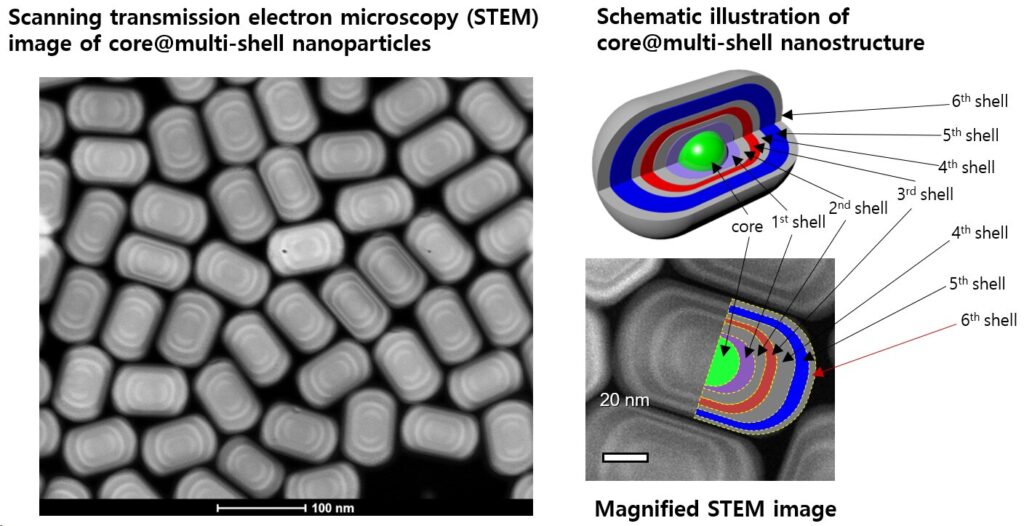Dr. Ho Seong Jang and colleagues at the Extreme Materials Research Center at the Korea Institute of Science and Technology (KIST) have developed an upconversion nanoparticle technology that introduces a core@multi-shell nanostructure, a multilayer structure in which multiple layers of shells surround a central core particle, and enables high color purity RGB light emission from a single nanoparticle by adjusting the infrared wavelength.
The work is published in the journal Advanced Functional Materials.
Luminescent materials are materials that light up on their own and are used in a variety of display devices, including TVs, tablets, monitors, and smartphones, to allow us to view a variety of images and videos. However, conventional two-dimensional flat displays cannot fully convey the three-dimensional dimensionality of the real world, limiting the sense of depth.
The movie “Avatar” attracted a lot of attention for its 3D images, but audiences had to wear special glasses to experience the sense of depth, and glasses-free 3D displays were developed to solve this inconvenience, but they have the disadvantage of causing eye fatigue.
To solve these problems, three-dimensional volumetric display technology is being researched. This is a next-generation display technology that implements three-dimensional image information in a three-dimensional space, which requires upconversion nanoparticles that absorb infrared light and emit visible light.
In particular, upconversion nanoparticles that can emit all three primary colors of light-red (R), green (G), and blue (B)-from a single nanoparticle are required, but existing materials either emit only one color from a single nanoparticle or, even if R/G/B emission is possible, brightness is low or the range of color reproduction is limited due to a narrow color gamut.
-

(Left) Chromaticity diagram showing the range of color reproduction achieved through R/G/B emission from core@multi-shell upconversion nanoparticles and the NTSC and sRGB color gamut. (Right) Photographs of luminescence from a core@multi-shell upconversion nanoparticle solution upon application of three wavelengths of near-infrared light and a combination of these wavelengths of near-infrared light. It can be seen that a variety of luminescent colors can be achieved from the upconversion nanoparticles developed in this work. Credit: Korea Institute of Science and Technology
-

(Top left) Photograph of a transparent polymer composite synthesized by dispersing core@multi-shell upconversion nanoparticles in a polydimethylsiloxane (PDMS) polymer. (Right) Photographs of various color images realized upon application of near-infrared light to the core@multi-shell upconversion nanoparticle-PDMS polymer composite, demonstrating that it is possible to achieve color displays of any desired shape using a near-infrared light source and the upconversion nanoparticle-polymer composite. Credit: Korea Institute of Science and Technology
The KIST researchers controlled the material composition of the core and shell to induce R/G/B luminescence from a single nanoparticle, and applied three wavelengths of near-infrared light to produce R/G/B luminescence at different excitation wavelengths.
In particular, they designed the core to emit green light, the inner shell to emit red light, and the outer shell to emit blue light, achieving high color purity and strong luminescence intensity of R/G/B luminescence in a single nanoparticle.
The nanoparticles developed by the researchers can realize various colors by applying multiple wavelengths of near-infrared light simultaneously, achieving a wide color gamut of 94.2% of the NTSC color space and 133% of the sRGB color space.
The researchers also demonstrated the possibility of realizing 3D volumetric displays using upconversion nanoparticles by fabricating transparent upconversion nanoparticle-polymer composites to display various color images.
“Upconversion nanoparticles that can absorb near-infrared light and produce high color reproduction full-color luminescence will enable the commercialization of 3D volumetric displays that can allow us to view true 3D images. These upconversion nanoparticles can be used not only in the display field but also as a security material to prevent counterfeiting and tampering,” said Dr. Ho Seong Jang.


